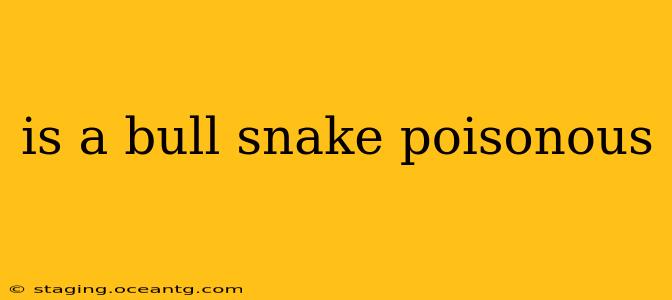The question, "Is a bull snake poisonous?" often pops up, fueled by a mix of misinformation and the snake's imposing size. The short answer is no, bull snakes are not venomous or poisonous. This is a crucial distinction to understand. Venomous snakes inject venom through fangs, while poisonous animals cause harm through touch or ingestion of their toxins (think poison dart frogs). Bull snakes belong to the completely non-venomous Lampropeltis genus, closely related to kingsnakes and milk snakes.
Let's delve deeper into clarifying this and addressing common misconceptions.
What Makes People Think Bull Snakes Are Poisonous?
The fear surrounding bull snakes stems from several factors:
- Size and Appearance: Bull snakes are large and powerful, often reaching lengths of 6 feet or more. Their size alone can be intimidating. Their coloration can also vary, sometimes resembling venomous species, leading to misidentification.
- Aggressive Defense Mechanisms: When threatened, bull snakes can exhibit defensive behaviors such as hissing, striking (without venom), and vibrating their tails to mimic a rattlesnake. This can scare people into believing they are venomous.
- Misinformation: Unfortunately, incorrect information spreads quickly, especially through word-of-mouth or outdated sources.
Are Bull Snakes Dangerous?
While not venomous, bull snakes can still pose a threat if handled improperly. Their large size means a bite can be painful, akin to a dog bite. However, there's no risk of venom injection. The most significant danger is the stress inflicted on the snake itself. Handling wild animals is generally not advised, and bull snakes are no exception. It's best to admire them from a safe distance.
What Do Bull Snakes Eat?
Bull snakes are constrictors, meaning they kill their prey by squeezing it tightly until it suffocates. Their diet primarily consists of rodents, making them beneficial to farmers and homeowners as natural pest control. They might also consume birds, eggs, and other reptiles, playing a vital role in the ecosystem.
How Can I Identify a Bull Snake?
Identifying a bull snake accurately is crucial to avoid unnecessary fear. Look for these characteristics:
- Smooth scales: Unlike some venomous snakes with keeled (ridged) scales.
- Round pupils: Venomous pit vipers have elliptical pupils.
- Distinct color patterns: Bull snakes have varied color patterns, but generally have noticeable bands or blotches. Regional variations exist, so checking local guides is beneficial.
What Should I Do If I Encounter a Bull Snake?
Observe the snake from a safe distance. Do not attempt to handle it. If the snake is in a location where it poses a risk to people or pets, contact your local animal control or wildlife rehabilitation center for assistance.
Are there any similar-looking venomous snakes I should be aware of?
While bull snakes are not venomous, several venomous snakes exist in similar habitats. Familiarizing yourself with the venomous snakes native to your region is crucial for safety. This can usually be accomplished through online resources or contacting local wildlife experts.
This detailed information should help dispel any myths about bull snakes being poisonous. Remember, appreciation and respect for wildlife go hand in hand with responsible observation and a commitment to keeping yourself and the snakes safe.
